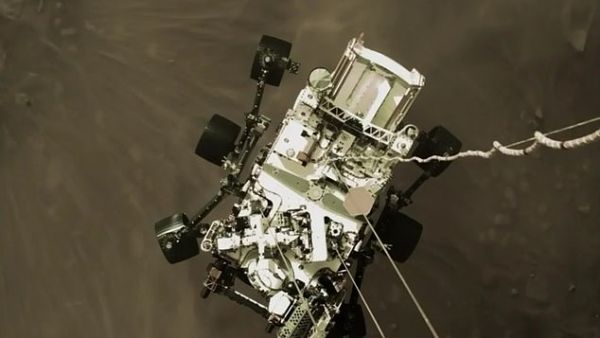The helicopter sent to Mars by NASA to explore the Red Planet from the sky has 'phoned home' and is working great, according to the space agency.
Named Ingenuity, it rode to Mars strapped to the belly of the car-sized Perseverance rover that will trundle along the Jezero crater in search of ancient alien life.
NASA mission control in Southern California received the first status report from Ingenuity late on Friday via the space-based Mars Reconnaissance Orbiter.
Ingenuity will remain attached the belly of Perseverance for between 30 and 60 days before it detaches and makes its maiden flight - assuming it survives the brutal average -90C overnight temperatures found on the Red Planet.
The downlink confirmed that the helicopter, and an electrical box on the rover that routes and stores communications with Earth, were both performing as expected.
'There are two big-ticket items we are looking for in the data: the state of charge of Ingenuity's batteries as well as confirmation the base station is operating as designed,' explained Tim Canham, Ingenuity project lead at JPL.
The base station works to command heaters to turn off and on and to keep the helicopter's electronics working within an expected range, he added.
'Both appear to be working great. With this positive report, we will move forward with tomorrow's charge of the helicopter's batteries.'
Once the batteries have been charged by Perseverance and mission control are happy it is working as expected, the little craft will be released.
NASA will then work to ensure the helicopter is able to charge its batteries through its onboard solar panels and that it can survive the hard freezing Martian nights.
Ensuring that Ingenuity has plenty of stored energy aboard to maintain heating and other vital functions while also maintaining optimal battery health is essential to the success of the Mars Helicopter, the space agency explained.
Initially Perseverance will give Ingenuity a 'one-hour power-up' that will boost the rotorcraft's batteries to about 30% of its total capacity.
A few days after that, they'll be charged again to reach 35%, with future charging sessions planned weekly while the helicopter is attached to the rover.
Now NASA knows the rover and helicopter can 'phone home' they'll compare charging data on Mars to data from charging while travelling to the planet.
After Perseverance deploys Ingenuity to the surface, the helicopter will then have a 30-Martian-day (31-Earth-day) experimental flight test window.
If Ingenuity survives its first bone-chilling Martian nights – where temperatures dip as low as minus 90 degrees Celsius – the team will proceed with the first flight of an aircraft on another world.
If Ingenuity succeeds in taking off and hovering during its first flight, over 90% of the project's goals will have been achieved.
If the rotorcraft lands successfully and remains operable, up to four more flights could be attempted, each one building on the success of the last.
'We are in uncharted territory, but this team is used to that,' said MiMi Aung, project manager for the Ingenuity Mars Helicopter at JPL.
'Just about every milestone from here through the end of our flight demonstration program will be a first, and each has to succeed for us to go on to the next. We'll enjoy this good news for the moment, but then we have to get back to work.'
Assuming Ingenuity is succesful, future Mars missions are likely to include an aerial component in the form of a rotorcraft - descendants of Ingenuity.
'These advanced robotic flying vehicles would offer a unique viewpoint not provided by current orbiters high overhead or by rovers and landers on the ground, providing high-definition images and reconnaissance for robots or humans, and enable access to terrain that is difficult for rovers to reach,' NASA explained.
NASA's $2.2 billion Perseverance rover and accompanying helicopter successfully landed on Mars on February 18 following a 239 million-mile journey.
The rover survived the 'seven minutes of terror' when it endured tumultuous conditions that battered the craft as it entered the Martian atmosphere and approached the surface.
Perseverance touched down at the base of an 820ft-deep (250m) crater called Jezero, a former lake which was home to water 3.5 billion years ago.
The Martian surface is littered with craters but what makes Jezero Crater so special is that it has an inflow and outflow channel, which suggests it was filled with water some 3.5 billion years ago.
New data, photos, videos and audio is being sent back to Earth by Perseverance all the time, with NASA set to reveal more at 19:00 GMT on February 22, 2021.
This article has been adapted from its original source.








